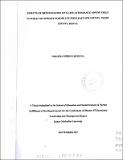| dc.description.abstract | Class absenteeism is a major factor contributing to poor academic performance. A lot of research work has gone into finding out the factors that are contributing to the gender disparity in class attendance. Among the major factors that make girls absent from class is menstruation. The purpose of the study was to establish effects of menstruation on class attendance among girls in public secondary schools in Kieni East Sub County, Nyeri County, Kenya. The study is hinged on the Social Learning Theory. The study used descriptive survey research design. It targeted students, class teachers and HoDs (Guidance and Counseling). Stratified random sampling technique was used to select the respondents. Questionnaires and interview guides were used to collecf data. Pilot study was carried out in the neighboring Laikipia East Sub County in order to increase validity and reliability of the research instruments. Data analysis employed both qualitative and quantitative techniques. Content analysis, descriptive and inferential statistics were employed to analyze the data. The study found out that on average, a girl loses 11 lessons per month due to physiological effects related to menstruation. The study also found out that socio cultural issues such as societal attitudes and perceptions surrounding menstruation have a bearing on class absenteeism due to stigma, misunderstanding and misconceptions about the whole issue of menstruation. In addition, the study found out that girls result to using alternative materials since they cannot access/ afford usual sanitary materials which pointed to the importance of the school intervention towards the welfare of girls undergoing menstruation. On the school factors related to menstruation and school attendance, the adequacy of toilet facilities for all the girls, location of toilets near the tuition area to make them more accessible to girls and toilet facilities providing adequate privacy to girls using them, were found to be important in influencing class attendance among the girls undergoing menstruation. Finally, the regression model of the four predictor variables against school attendance was found to be significant (p < 0.05). The resulting goodness of fit was R2 = 0.524 indicating that52.4% of the variability in the school attendance is explained by the four predictor variables and thus, the four independent variables tested were found to be predictors of school absenteeism due to menstruation. Based on the findings, the study recommends that the school should make sanitary towels available for use by girl students. Schools should make the toilet facilities more appropriate for use and also provide adequate toilet facilities and sanitary materials, construct more toilets as well as providing adequate toilet and sanitary materials. | en_US |

